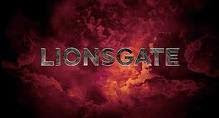Tuesday, 10 May 2011
Wednesday, 4 May 2011
How did you use media technologies in the construction and research, planning and evaluation stages?
The above video is over 30 minutes long which means it is very big in size. As blogger only allows certain size videos to be uploaded we had to have the video reduced in size in order to show all of the quality in the video. The downside to this is that the sound, as well as visual quality of the video has been reduced. This is the reason in which the sound is slightly off.
The origional larger sized film which is of much better quality can be found by following the link below
http://www.youtube.com/watch?v=BN36zp0ao4U&feature=channel_video_title
What have you learned from your audience feedback?
Overall we received very positive responses from the audience and took onboard what they had to say. The main thing that needed changed was the last shot which was too long. As well as this a majority of people said that it would be better if the sound had ended before the final text cards. So I went back the raw product and shortened the final shot and fade the music out slightly earlier.
Without the audience feedback none of us would have thought to do this, but in carrying out the modifications suggested we have created a much stronger product.
Questionnaire
After handing out our questionnaires to a random sample of the target audience we took them back in and went through them to see what our findings were. Overall we found that our trailer was liked and would be seen by most of the target audience.
As well as generic questions we also gave the audience a specific question. In the pie carts below the copy of the questionnaire, pie number five represents the answer the question I asked the audience 'What do you think of the use of locations and props within the trailer'
Below is a copy of the questionnaires we handed to the audience.
Results:
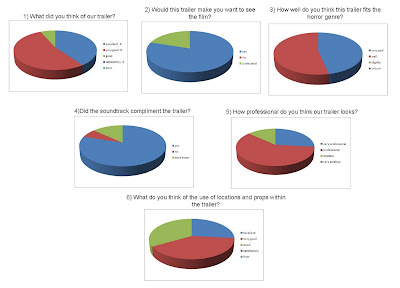 For the questionnaire we used a mixture of open and closed questions. The main reason for this was so we were able to show some findings in the form of pie charts as well as being able to receive feedback from people. As the pie charts above show, our trailer was well liked by the audience it was shown to. The open questions were very useful and the main thing we found was that the last shot could benefit from being made shorter. With this knowledge we then went back to the drawing boards to make some final adjustments.
For the questionnaire we used a mixture of open and closed questions. The main reason for this was so we were able to show some findings in the form of pie charts as well as being able to receive feedback from people. As the pie charts above show, our trailer was well liked by the audience it was shown to. The open questions were very useful and the main thing we found was that the last shot could benefit from being made shorter. With this knowledge we then went back to the drawing boards to make some final adjustments.As well as this we found out that most of the audience we asked would prefer the music to end before the final credits. We also made these adjustments to the trailer in order to further satisfy the audience.
Overall I feel that the audience feedback session went very well and help us to make some very good final adjustments to our trailer
In what ways does your media product use, develop or challenge forms and conventions of real media products?
As well as the theories mentioned above, i also found some quotes which can be related to our trailer.
John Fiske (1988) ‘attempts to structure some order into the wide range of texts and meanings that circulate in our culture for the convenience of both producers and audiences’
This quote relates the theory provided by Todarov as it relates to different stages within a piece of media, in this case the horror trailer. And as i have shown above our trailer does not follow the conventional steps to a trailer, but it does include them. This enables the audience to understand the media text but at the same time as being slightly confused
How effective is the combination of your main product and ancillary tasks?
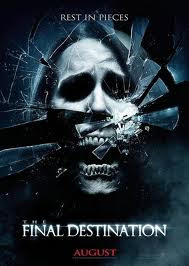
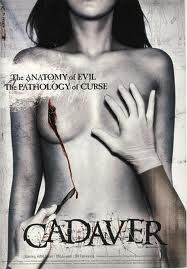
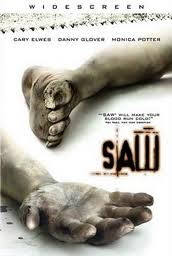
The main product can be shown in a variety of places on the internet, but the poster and magazine will be able to be seen in shops, on billboards, on bus stops, in shop windows, on trains (below) as well as being able to be found on the internet. The wider audience reached by creating print work pieces which are directly linked to the trailer maximises the possible audience by showing them a glimpse of the film without them necessarily having to be in the cinema or online.
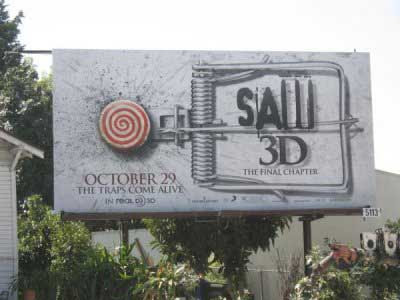

The main product, however, is able to be shown on a multiplicity of websites which will give it a much larger audience who are able to comment and give feedback to the product itself. Websites that it could be featured on include ‘bloodydisgusting.com’ ‘YouTube’ as well as social networking sites such as Facebook and Myspace (below).
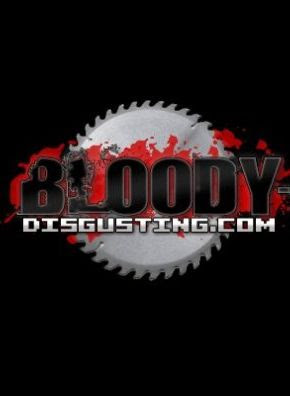



This type of advertising is called viral marketing and is a great way of advertising out final piece, especially because the target age group is 15-25. This means that most of them will have access to the internet, probably on more than one level, be it computer, laptop, mobile phone or iPod. Viral marketing is a very cheap way to advertise and, as we have no budget, it would suit our film well. The best example of viral marketing is ‘Paranormal Activity’ (below) which was involved in a massive advertising campaign in which people had to vote where the film was shown, giving the audience a very good sense of false ownership.

The main thing about being able to use a variety of websites is the fact that I have combined the process of ‘producing’ and ‘consuming’ in order to become a prosumer. This has gave me many advantages but the main one is me being able to produce a product at the same time as enjoying already existing ones, which also aided in production
By using the production name ‘Lionsgate’ we are already implying that the product will be of good quality. The main reason for this is because ‘Lionsgate’ is a reputable and international production company which is known by the consumer for being a good independent company. They have produced things such as the Saw sage and Hostel
